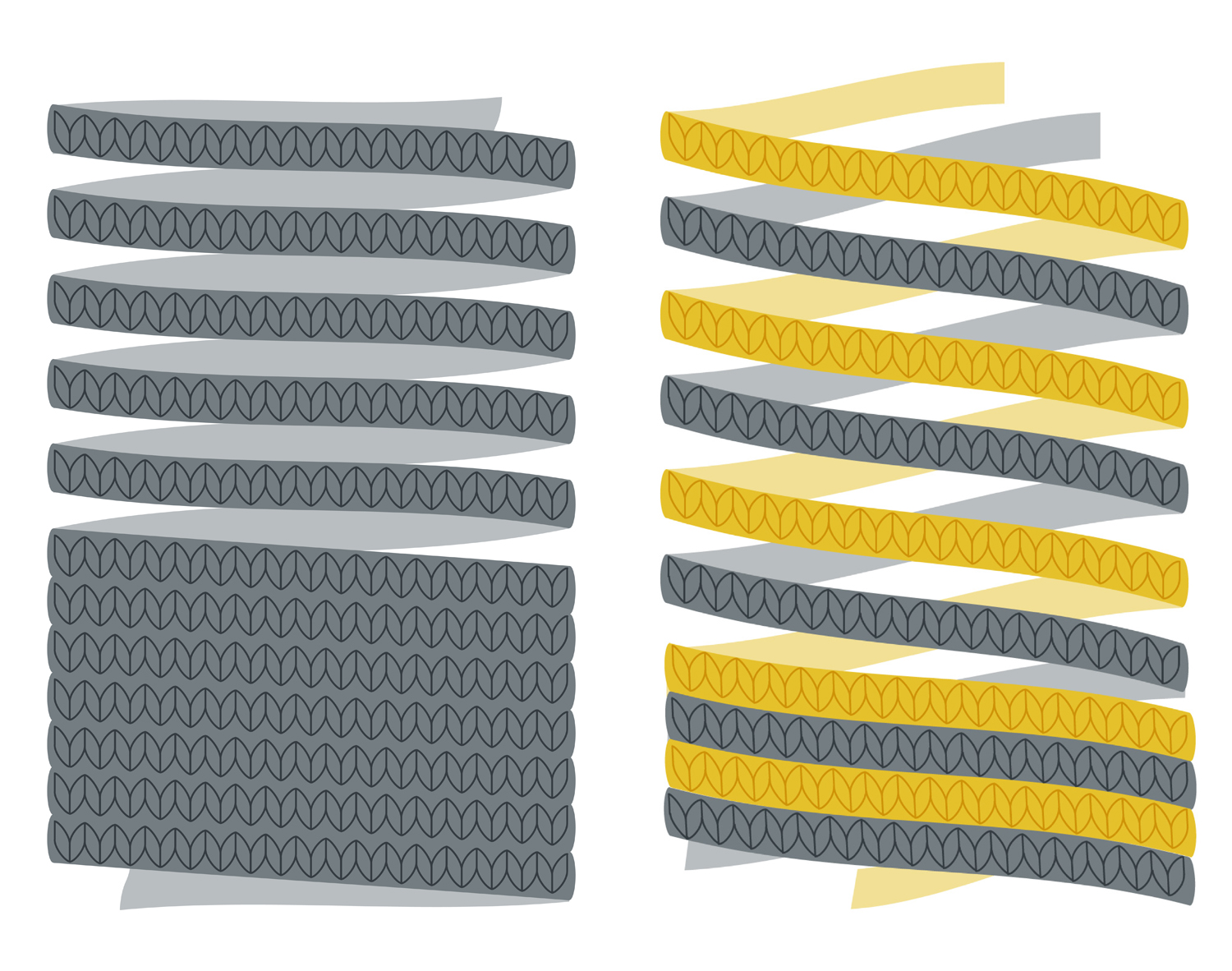Intrigued by the idea of helical knitting? Have you knitted 1x1 helical stripes, but would like to know more about working more complex stripes? Would you like to know more about using helical stitch patterns? Or are you just keen to try something new in your knitting? Then this is the ebook for you!
Something New to Learn About Helical Knitting will be delivered as an ebook in four fortnightly chapters, with the first being released on Tuesday 9th October.
Read moreWhilst jogless stripes are the most well-known application of helical knitting, I have become captivated with other possibilities for helical stitch patterns. Working helically is just (in my humble opinion) a heap of fun. It’s satisfying and simple, and at the same time can create quite complex fabrics with a minimum of fuss.
Helical knitting is sometimes a solution to a problem, but in other situations it’s just an elegant approach to a stitch pattern.
Read moreJim and I love almost every aspect of running Arnall-Culliford Knitwear, but one of the tasks that we procrastinate the most is the naming of patterns. There are so many things to think about when you choose a pattern name. Has it been used before? Does it relate to the design in question? Is there a theme to the collection and does the name fit with the theme? And most importantly, does the name have unexpected connotations, both here in the UK and internationally? When I’m thinking about a pattern name I have learned the hard way to look it up on Google as well as Ravelry. I once worked on a collection where one of the patterns now shares a name with a cream used for a rather unspeakable ailment…
Read moreWhen you knit in the round, you aren’t working discrete, complete rounds, in the same way as you would work a row in flat knitting. Your knitting isn’t a series of rings of stitches sat on top of each other. Instead, in each round you are working a complete circuit or 360° turn of a helix. This is important because it means that the first stitch in your round is not adjacent to the last stitch in your round. In normal knitting you work a single, complete spiral of stitches, where the last stitch of the previous round is adjacent to the first stitch of the next round. Helical knitting turns this on its head, and sets up multiple spirals all sitting on top of each other.
Read moreI’ve been thinking about helical knitting.
A LOT.
I’ve been aware of helical knitting since I published my first pattern in June 2009 (Spiralling Socks, The Knitter, issue 7), and the sense of magic it inspires in me isn’t really matched by any other knitting technique. I am very partial to a neat tubular cast on, colourwork is a joy to do, and cables and lace make me feel clever, but helical knitting is just pure magic. The time finally came this year to sit down and explore it further. Much further.
Read moreWe're nearly at the end of the second week of the lace knitalong and already there is plenty to admire. The brief for the KAL is simple: knit a lace project, post photos on the Ravelry forum and tag your project with SN2LAL.
Read moreWe have had a busy few days, and all of the print copies of Something New to Learn About Lace have now been shipped, so hopefully parcels will start landing on doormats very shortly. I am looking forward to casting on for a Nissolia shawl very shortly. In the meantime, here is the next in our video tutorial series...
Read moreDo you know that horrible feeling you get when you look down at your knitting and realise that you've made a big mistake, and it's too far back to just unknit a row or two? I certainly do! Many people think that as you get more experienced at knitting, you stop making mistakes, but that's absolutely not the case! I think it was the Yarn Harlot who said that experienced knitters just make bigger mistakes more quickly, and she's ABSOLUTELY right!
Read moreThe garter tab cast-on method is a really clever way to start a triangular shawl. It allows you to set up your knitting in three perpendicular directions, without an obvious start or finish. The video below shows you exactly how to work the cast on, starting with a provisional crochet cast on, working through the garter tab and then picking up the stitches around the edges of the tab. This is the cast-on method I've used in my Bithynica shawl, shown above.
Read moreStitch markers are one of the most useful tools in knitting. Whether you're keeping track of shaping elements in a garment, or establishing a lace pattern, these simple rings, or even just a loop of waste yarn, can instantly make a pattern more straightforward.
The video below is the second in our Something New to Learn About Lace series, and explains how to use stitch markers to keep track of your lace knitting.
Read more







